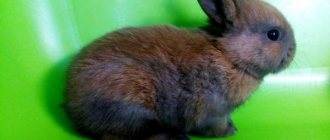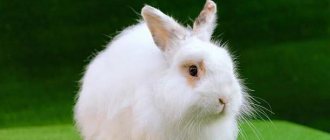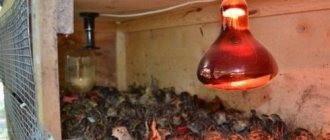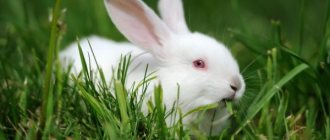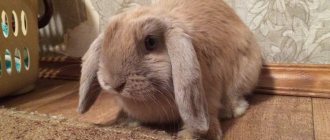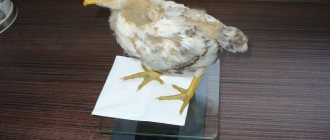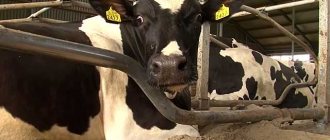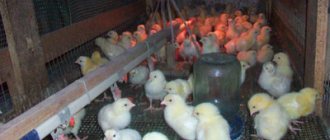Choosing a breed of decorative rabbits for beginner rabbit breeders
Decorative rabbit
Decorative breeds of rabbits can be kept in an apartment. It is better to choose short-haired breeds in order to spend less time caring for your pet’s coat. Particularly popular is the “loop-eared ram” rabbit, which has long hanging ears. Decorative rabbits are loyal to their owners, do not damage furniture, live long, do not need to be walked every day, are pleasant to touch, and are quiet. The lifespan of a decorative rabbit is 12 years. You can castrate such a rabbit at an early age, and then keeping such a pet at home will not cause problems.
Below are the breeds of decorative rabbits:
- Short-haired colored dwarfs with shiny fur and small ears;
- Rex rabbits with plush fur;
- “Lop-eared rams” with a calm character and drooping ears;
- Angora dwarfs with fur up to twenty centimeters long (this coat will require good care).
- For beginning rabbit breeders, it is better not to have Hermelins, because the females have a rather difficult character. Male hermelins (white decorative rabbit or ermine) have a magnificent fur coat, but due to the fact that the wool is very dense, it is difficult for them to tolerate the increased air temperature in the apartment, and by their nature, hermelins are distinguished by exceptional laziness.
Choosing a breed for breeding
Depending on what kind of product the future farmer wants to receive, he can choose the following options for economic breeds:
- Meat, representatives of which are distinguished by their large size (weight can reach 20 kg), early maturity and the ability to quickly gain weight. Their meat has a delicate taste and high nutritional value; the layer of fat is small. Fur is not in demand.
- Skin (meat-skin), which will provide both excellent meat and high-quality skin. The “coat” of skin rabbits contains mainly coarse hairs, and the undercoat is weakly expressed. The average live weight for them is 10 kg.
- Down, which is bred for the purpose of obtaining fur, meat and skins are considered by-products. A feature of downy breeds is the presence of a large amount of undercoat fluff, hard hairs make up 5%. The weight of a downy rabbit is usually limited to 5-6 kg.
In addition, it is possible to purchase rabbits as pets.
In this case, you should focus on representatives of decorative breeds that have a number of features:
- small sizes (weight – 1-2 kg);
- peaceful disposition;
- relatively high intelligence.
Content Basics
Basics of keeping a decorative rabbit
Keeping a decorative rabbit requires a serious approach, responsibility and considerable knowledge of care. The key rule is to first purchase a cage and the necessary equipment and only then purchase a rabbit. These pets do not tolerate overheating, direct sunlight, or stuffiness, but at a temperature of -20° C they will feel great. Excessive levels of ammonia, hydrogen sulfide, carbon dioxide in the air, dampness, high humidity, and drafts are harmful to them. By the way, these animals do not sweat. The most comfortable temperature for them is: +18-20° C , humidity 50%. Heat exchange occurs through the veins in the ears. If your pet does not tolerate heat well, you can wipe its ears with a cloth soaked in cold water. If you cool your ears, your rabbit will feel better. You can cover the cage with a wet towel, or you can also put a plastic bottle with some ice cubes in the cage.
At home, the rabbit should be kept in a cage. These are fearful animals with a fragile spine; hold them tightly in your arms. A rabbit can even die if a person lets it go from a certain height. The animal does not need to communicate with the cat and dog, because they can start chasing the pet, and such races are harmful for him. You should not have a pet if there is a baby in the family. The curiosity of children pushes them to grab the animal by the ears, by the skin; as a result, the rabbit, having survived such shocks, can get sick.
Since decorative rabbits are delicate creatures, they can instantly catch a cold from a draft and die from stuffiness. Do not place your rabbit's cage in the sun . The animal can make noise, so in the morning you need to secure a grain feeder, tray, and hay manger in the cage in the morning. If the equipment is poorly attached, he will play with the feeder and everything else. There should always be dry bedding in the cage; it should be placed at the bottom of the cage. Straw or sawdust is suitable for bedding. At least 3 times a week you need to clean and change the litter. Stomach diseases are often caused by dirty and wet litter.
Rabbits are clean animals, so you should wash the litter box daily. Know that the pet will not go to the dirty litter box, but will equip a new toilet nearby. Some people don't like the smell of their pet, but if you take care of it, there will be no smell.
Basic requirements for keeping rabbits
Keeping a rabbit at home requires the future owner to take a serious approach and have some knowledge about caring for the animal. This animal is very vulnerable and does not tolerate:
- dampness;
- dirt;
- draft;
- temperature changes;
- extreme heat;
- stressful situations.
All these factors can negatively affect the health of the rodent and even shorten its life. Anyone who wants to have a decorative rabbit at home first needs to learn more about its characteristics.
There are strict requirements for keeping and caring for a pet:
- The room temperature should vary from +18 to +25 degrees. If the thermometer readings are high, your pet is at risk of overheating. Some individuals die from hyperthermia. Sharp fluctuations in the mercury column are unacceptable.
- Humidity – 50-60%. Too dry and very humid air is equally harmful to the health of a decorative rabbit. In such conditions the rodent will get sick.
- Good ventilation is important when caring for an animal. The room should be ventilated, but it is important to ensure that the pet is not in a draft. This can lead to a cold.
- Calm environment. Decorative rabbits are very timid, some die from stress. If there are small children in the house, you need to explain to them how to properly handle the animal - you cannot make noise, grab it or press it too hard.
- Purity. Cage care is very important. It is necessary to change the litter at least once a week. In sawdust that is wet and dirty from urine and droppings, microbes multiply and can cause various diseases in your pet.
Important! Heat exchange in rabbits occurs through the skin of the ears. When a rodent is very hot, the ears become hot. To cool your pet, you should wipe them with a damp cloth.
Contents in a cage
The cage should be spacious - four times the size of the animal. The cage should have enough space for a tray, drinking bowls, feeders, and a resting house. Take a plastic tray for the cage. A lattice tray will not work because the rabbit's feet will not be able to adjust to the tray. Avoid putting sawdust or straw in the bottom of the cage to prevent your rabbit from constantly peeing all over the cage. The cage must have a non-slip bottom. You can pour straw, paper, sawdust, and shavings from deciduous trees into the tray. A heavy ceramic bowl is suitable for grain feed. Attach the automatic drinking bowl and hay manger to the bars of the cage.
Choosing a cage for a decorative rabbit
Cages for decorative rabbits
Decorative rabbits do not need a huge cage. The standard cage size for them is 1 m. The cage size for the largest individuals should be up to 140cm. Over time, the animal grows, and if you bought a small cage, the pet will feel cramped and get sick from sitting still. Keep in mind that an adult pet spends a lot of time in a cage, and not just spends the night. To maintain animal hygiene, you will definitely need a grid on the pallet. You will also need convenient drinking bowls, feeders, and a hay barn. You can install a house in a cage, but it makes sense to do this only in spacious cages where dwarf rabbits live. For a pregnant rabbit, you can temporarily install a house in a cage, in which she will arrange a place for the rabbits.
Some notes from the owners' experience
It is the reviews and experience of owners of furry animals that help them decide whether to get a rabbit or not. A few recommendations:
- when traveling with rabbits, you need to prepare the same package of documents as when transporting cats/dogs (a passport with vaccination records and a “fresh” certificate from a veterinarian are required);
- Rabbits are social animals and if the owners are constantly at work, then the animal may not fit into the family, will be scared of everyone and may even bite. Some owners note that the rabbit recognizes one owner and is reluctant to go into the arms of other people;
- If there are small active children in the family, then it is not recommended to have a small pet. You can purchase an animal for a child aged 10-13 years. Small children will not be able to seriously care for the animal and may frighten it;
- rabbits are calmer than female rabbits. Although this feature is also determined by the character of the individual. Fluffies get along well with other pets;
- owners like that the rabbits are not allowed to walk outside, and that minimal time is required for servicing the animals and cleaning the cage.
It is possible to train the animal to respond to its name and to its litter box. It is worth remembering that a rabbit is an animal that bites and is capable of throwing itself in the face. They also take into account the timid nature of animals; they should not be left alone for a long time. Cute creatures evoke affection in both children and adults. Animals require a minimum of care and always respond to affection and attention. In order for animals to fully develop, it is necessary to choose the right food and arrange a suitable place for keeping them.
Selecting a location
Choosing a place for a rabbit
You should not place a cage with a rabbit near a radiator or near air conditioners. For these pets, any overheating is dangerous. At a temperature of +20°C, rabbits will be very comfortable. Animals are afraid of other pets, computers, TV, bright sunlight, and drafts.
It would be ideal to place the cage away from noise sources and away from the window. It is important that the place is bright and calm. The hallway, kitchen, corridor will not fit. When ventilating the room, avoid drafts. If you place the cage on the loggia, you will increase the likelihood of the animal overheating. Keep in mind that the loggia must have good ventilation and suitable temperature conditions.
For owners of private houses, you can make an enclosure with a canopy and fence it with a small fence. This way, the animal will not be afraid of either rain or overheating, and you can let the rabbit walk outside in the summer.
Cleaning a Rabbit Cage
The cage should be cleaned regularly. Clean the litter box a couple of times a week . The litter in the tray needs to be swept and replaced. The cage should be washed periodically using a disinfectant. Outdoor cages need to be washed weekly. Due to the fact that dirt is attractive to flies, the cages are washed more often in the summer. To make cleaning easier, place a potty in the cage and wash it regularly. Superficial cleaning should be done every day. While the rabbit is walking, clean the cage. It is important to remove excess wool and hay, wash the drinking bowl, and shake the hay.
Disinfectants are used for thorough cleaning, however, it is important to understand that pets are highly sensitive to chemicals.
Delegol is perfect for cleaning cells. Instructions are included with it. Before cleaning the cage with chemicals, move the pets to another cage or to another place.
A rabbit may develop a runny nose, sneezing, and watery eyes – all due to the fur not being collected in time. The owner of a rabbit can get allergies from dust and dirt. Flies also have no place in a cage. You need to take care of your pet.
Smell
Decorative rabbit
The rabbit is a clean animal. There is almost no smell from the baby rabbit. The cage may smell like bedding and food. The owners will need to regularly clean and disinfect the cage, change the bedding in the sleeping house, as well as the litter in the toilet area. If the rabbit reaches sexual maturity, the stool is disturbed or the cleaning regime is not followed, then the smell of the rabbit becomes more noticeable. There is nothing you can do about the smell from a mature rabbit, and other causes are easy to eliminate. Having matured, individuals (both females and males) mark their territory and scatter feces throughout the cage and around the apartment.
Bathing your pets will not get rid of the smell, because secretion products, not skin secretions, are the source of the smell. A rabbit can independently clean its fur from odors or any dirt.
If you do not intend to breed your pets, then you can sterilize them . If you want offspring, clean the cages more often. A solution of potassium permanganate is suitable for cleaning. Laundry detergents, dishwashing detergents, and cleaning products are not suitable for cleaning cages - their use will have a bad effect on the rabbit’s health.
Conditions of detention
Decorative rabbits need good care. The owner must provide them with proper living conditions. Before purchasing a pet, you need to buy a cage, equipment, and also decide which corner of the apartment will be allocated for it.
Cell selection
The choice of cage must be approached with the utmost seriousness, because the pet will spend most of its life in it. What to pay attention to:
- Size. The home of a decorative rabbit should be spacious - about 4-5 times the size of the pet itself. Inside a good cage there is a tray, a manger for hay, a bowl for food, a house for sleeping, while still leaving free space for the pet to move and play.
- Quality of materials. It is better to give preference to a cage made of metal with a fine lattice; it should not be painted. Plastic cages often contain harmful impurities, which can cause the animal to develop allergies.
- Safety. The rabbit's housing should not have sharp parts, otherwise the animal will be injured.
- Structural strength. The cage should last at least 3-4 years. Don't forget that rabbits will chew parts of their homes.
- Floor. It is best to choose a cage with a smooth floor rather than a lattice floor, otherwise your pet's delicate paws will suffer. Because of the bars on the floor, rabbits sometimes develop a disease called pododermatitis.
Advice. If you plan to keep several pets, then it is advisable to provide each of them with a separate home. It is permissible to keep two castrated males, female rabbits from the same litter, or a female and a male together.
Selecting a location
A decorative rabbit in an apartment will feel comfortable if you choose the right place to place the cage. Eared animals are afraid of cold, drafts and extreme heat. In such conditions they may die. In addition, the animals are shy. This means that the cage should be installed in a secluded place where the pet will be calm.
Rabbit in a cage
Unsuitable places for the cage:
- A walk-through corridor where children run and strangers come in.
- Children bedroom. A child may develop allergies due to constant contact with animals.
- Kitchen.
- Cold loggia. If the balcony is not insulated, the animal will be cold. The optimal temperature for keeping decorative rabbits is from +16 to +24 degrees.
You can put the cage in the living room, where the whole family gathers to relax and communicate together. A glazed and insulated loggia is an excellent choice. No one will disturb the rabbit there, but it is important to make sure that the cage is not in a draft or in direct sunlight. It is better to place the rabbit's home on a low stand or cabinet, rather than on the floor.
Important! The cage must not be installed near an air conditioner or heating radiators.
Additional inventory
In addition to a home, the rabbit will need other equipment that will help him feel comfortable. What items should you buy when deciding to get a decorative rabbit:
- Tray - one or more. One tray is installed inside the cage, the other in the apartment. The toilet should have high sides on three sides so that the filler does not spill out onto the floor. Choose a tray that is spacious so that the rabbit can use it comfortably.
- Drinking bowl. Pet stores sell automatic waterers for rabbits. Their advantage is that they cannot be turned over, they are attached to the cage bars, and the water there remains fresh for a long time. You can make a drinking bowl with your own hands from a plastic bottle.
- Hay manger. Eared ears include hay in their diet every day. The daily intake is a bunch the size of a pet. It is placed in a special feeder. Stores sell mangers that are attached to the cage or placed on the floor. The first option is more convenient.
- Bowl for feed. Rabbits are mobile, so you should choose a heavy bowl that is difficult to tip over. It is worth considering the option of a feeder mounted on the cage wall.
- Carrying. The owner of the animal will certainly need a plastic carrier if he needs to be taken to the veterinarian for an examination or vaccination.
- Toys. The decorative rabbit loves to spend time actively. It is worth placing several toys in the cage, for example, a wheel or various devices - labyrinths, mats. The pet will enjoy playing with them - gnawing, running, disassembling, scratching.
- House for a rabbit. Your pet must have a secluded corner where he can hide from danger or simply relax. A small house is placed in a cage.
Rabbit house
Walks
Walking bunny at home
Movement is important for a rabbit's health. Even a huge cage will limit the pet’s mobility, and this will lead to nervous disorders, joint diseases, and decreased immunity. To keep the animal healthy, let it walk around the apartment at least 20 minutes a day. Make sure that there are no cans of detergents, cords, electrical cables, or poisonous indoor plants in the apartment. Make sure there are no small cracks, as a curious animal could get stuck there. Constantly monitor your pet’s movements, especially if you don’t know its preferences and behavioral characteristics. And even old rabbits should not be left unattended for a long time.
The rabbit needs toys, otherwise he will find toys for himself from household items. As a result, various objects will be lying around the apartment, chewed into pieces.
You can increase the area for walking every day, but usually one room is enough for him. It is quite difficult to absolutely secure the entire apartment.
During a walk, the cage should be kept open - if the pet needs something, it should be easy to get home. The tray can be taken out of the cage. It is important to train your rabbit to go to the toilet in a litter tray.
On the street, the rabbit should be walked only in clean places, otherwise it may eat dirty grass. After your walk, inspect your rabbit for ticks.
Cage selection and equipment
Before purchasing a decorative rabbit, you should take care to create favorable conditions for its maintenance. You need to buy a comfortable cage and equipment. The rodent will spend most of its time in its home, so it should be comfortable.
It is also important to find a suitable place in the apartment to place the pet. This could be a hall, a living room, or a distant, quiet room.
It is better to place the home of a decorative rabbit on a cabinet or table in the back of the room so that it is not exposed to direct sunlight from the window.
Important! A rodent's cage cannot be located near a heating radiator - it is too hot there in winter.
Dimensions of the home
Decorative rabbits are kept in cages. When choosing a home for a rodent, the breed of the rodent is taken into account. There are many breeds for home keeping and, as a rule, these are medium-sized animals whose weight ranges from 1.5 to 2.5 kg.
True, there are mini rabbits - these are tiny rodents weighing from 600 g to 1.4 kg.
Attention! Before you buy a cage to keep a rabbit, it is important to decide what breed you plan to have.
For small decorative rabbits, whose weight does not exceed 1.5 kg, a dwelling with dimensions of 0.8 x 0.6 m is suitable. To keep larger rodents, you should buy a larger cage - 1 m long and at least 0.6 m wide. The height of the structure should allow the pet to stand on its hind legs, which is approximately 60 cm.
If you plan to breed decorative rabbits, you will need 2 cages. One is for keeping the male, the other is for the female. You can purchase a two-section design, the parts of which are separated by a partition.
The main thing is that each pet has enough free space inside. To keep the rabbits after leaving the mother, you will need a separate home.
Design requirements
A cage for a decorative rabbit should be comfortable both for its future inhabitant and for the owner of the rodent. It is important that it is easy to care for. It’s good if the product is equipped with a retractable plastic tray, it is easy to clean and remove droppings. The cage should be made of either wood and metal or galvanized mesh and be equipped with a securely closing door.
Important! When purchasing a home for keeping a decorative rabbit, it is important to make sure that there are no sharp elements inside that could injure the animal.
Inventory
A decorative rabbit will need 2 feeders - one for dry food, the other for succulent food. You also need to buy a sennik - a box for dry grass. Hay should not lie on the floor along with rodent excrement. Still need a drinking bowl. It is better to give preference to automatic or nipple. It is attached to the outside of the cage, and the spout that supplies water goes inside through the grate. This type of drinker cannot be knocked over. In addition, the water in it remains clean longer, does not bloom, and caring for such a container is very simple.
Another important attribute of a decorative rabbit’s home is a house. It is necessary for the pet to hide there when it is afraid of something. This is a kind of shelter where the animal can rest and recover from stress.
The house will serve as a nest for a rabbit who is going to become a mother. It is selected taking into account the size of the animal. The pet should be comfortable lying and turning around inside.
A tray for a decorative rabbit is installed in the apartment. It is quite bulky, so it is unlikely to fit in the cage. It is difficult to train a pet to go to the toilet in a specially designated place, but many succeed. Decorative rabbits go into a tray with litter when they are let out to walk around the house.
When they are in their home, they relieve themselves right on the floor. Therefore, it is advisable to pour filler - straw or wood shavings - onto the bottom of the cage.
Rabbit food
Rabbit food
The basis of the diet should be hay, clean water, feed, branches, and special mineral stones. Compound feed is granules with a complex of necessary substances. When choosing between special feed and mixed feed, give preference to the latter. In order for pets to grow well, they are given not only feed. A decorative rabbit may not immediately eat the granules, because it will first feast on tasty grains, and then all the remaining ones. It is important not to remove the pellets as they regulate digestion and are important for your rabbit's teeth. Rabbits are given 1 tablespoon of feed 3 times a day. Adult rabbits are given 1-1.5 tablespoons 2 times a day. There should be a lot of hay in the cage. Make sure there is always hay in the cage. Eating hay forms good stool and helps grind teeth. You can occasionally give a white cracker. Twigs of pear, birch, willow, apple, oak, poplar, and aspen are suitable for grinding down teeth. In summer you can give a few deciduous branches with leaves, in winter - coniferous branches. Wash and dry the branches well, and collect them in uncontaminated places. A chalk, salt or vitamin stone will provide your rabbit with minerals and vitamins. Chilled boiled water will be an ideal addition to your pet's diet. The water must be clean and present at all times. The water should be changed every 1-1.5 days. Rabbits are not fed parsley and dill due to the high content of essential oils. Chamomile, yarrow, and mouse peas are suitable for a decorative rabbit. It is not worth giving a lot of alfalfa. Herbs are introduced into the diet one leaf at a time. If you find an upset stomach, immediately remove herbs from your diet. Rabbits are fed herbs and fruits starting from 4 months. Herbs should be divided into small bunches, and fruits should be cut into miniature pieces.
How to care for a decorative rabbit?
Caring for a decorative rabbit in an apartment includes taking care of its health, including the condition of its teeth, claws and fur. The animal must be provided with adequate nutrition. It is important to get vaccinated against dangerous diseases on time, and at the first symptoms of illness, take your rabbit to the veterinarian.
Nail care
A decorative rabbit's claws constantly grow. They need to be trimmed using special clippers with a limiter every 3 weeks. This procedure will avoid injuries that the rabbit can cause to itself and family members. To shorten the claws, you need to enlist the help of someone in the household. The pet is held tightly so that it does not twitch. Otherwise, there is a high risk of touching the vessels that are located at the base of the claws.
Attention! When trimming the nails, you should leave a length of about 2 mm so as not to injure the capillaries. If this happens accidentally, you can stop the bleeding using cotton wool soaked in a solution of hydrogen peroxide (3%).
Grooming
If a decorative rabbit has very long hair, it needs to be combed daily with a special brush. Otherwise, tangles will form that are not so easy to get rid of.
Brushing a rabbit
During molting, which occurs in rabbits twice a year, you need to comb the fur as often as possible so that the pet does not eat too much hair while licking itself. This is dangerous as it can lead to blockage of the digestive tract.
Attention! Rabbits cannot shed fur like cats.
You cannot bathe an ornamental pet, except if chemicals that pose a health hazard have come into contact with its fur. In other cases, the animal is allowed to be partially washed.
Hygiene in the cage
Your pet's home must always be kept clean, otherwise he will get sick. The bedding is changed regularly, and any remaining food that the rabbit does not eat is thrown away. Litter must be removed every day. The tray is completely washed every 3-5 days. The cage is disinfected once a month or after the pet gets sick.
Diseases and mandatory vaccinations for rabbits
Vaccinations for rabbits
Decorative rabbits suffer from infectious stomatitis, staphyllococcosis, myxomatosis, infectious rhinitis, pasteurellosis, and coccidiosis. Animals also suffer from intestinal disorders (constipation is not uncommon in rabbits), eye diseases, their ears may hurt, and problems are caused by excessive tooth growth. Worm infestations can lead to the death of a pet. Three to four times a year, the animal should be dewormed, even if it does not go out into nature or go anywhere . Vaccination helps protect your pet from any infectious diseases. Read more in the article vaccination of rabbits.
It would be a good idea to vaccinate your pets against paratyphoid, rabies, listeriosis, and pasteurellosis. Vaccines against VHD (viral hemorrhagic disease) and against myxomatosis are required. There are vaccines that help protect against several diseases at once.
Once a year you need to get a comprehensive vaccination against miscomatosis and VGBV. It can be done using one ampoule. When there are outbreaks of other diseases in the region, then vaccinate your decorative rabbit.
At six weeks, rabbits receive their first vaccination against VGBV. If there is a threat of an epidemic, then four-week-old pets can be vaccinated. Three months later, the next vaccination against VGBV is given. Vaccination should be repeated every six months.
Vaccination against myxomatosis should be carried out from April to October, since this disease is transmitted by fleas, mosquitoes, and other blood-sucking insects in the warm season. There is no need to vaccinate your pet against myxomatosis in winter. At least two weeks should pass between vaccinations with separate vaccines against myxomatosis and VGBV. It is not advisable to vaccinate lactating females and pregnant rabbits. If your pet is infected, then there is no point in getting vaccinated, because it will not have any effect on the disease. Only healthy animals can be vaccinated. After vaccination, you need to keep the decorative rabbit in quarantine for two weeks - during this time the vaccine will begin to act, and the animal will not become infected. It is advisable to deworm your pet ten days before vaccination. You can vaccinate yourself or go to a veterinary hospital. But, if you vaccinate a rabbit, be sure to follow the vaccination schedule.
Sexual issue in rabbits
Decorative rabbit
Key signs of puberty:
- The pet has become aggressive and overly active;
- Goes to the toilet not in the tray, but wherever he wants;
- Females and males begin to actively dig the floor, the bottom of the cage, the carpet;
- Mark the territory;
- Manifestation of false pregnancy: the rabbit can pull out fluff from herself, carry hay to a certain place;
- A pet can molest domestic animals and humans.
- There is no medication yet to reduce sexual activity in rabbits. Exit: castration or sterilization.
- Castration can be performed on a ten-week-old rabbit, but veterinarians recommend castration on a five-month-old animal. Castration is a simple operation. Sterilization can only be carried out on a six-month-old rabbit. This operation involves removing the uterus and both ovaries.
- It is better to perform the operation on a young rabbit, since he has few health problems. The operating procedure will be dangerous for the old rabbit. Due to the fact that rabbits have difficulty withstanding anesthesia, these operations were previously considered incredibly dangerous. But now there is a new generation of anesthetics for this purpose.
Rabbit as a pet
Contents hide
In the wild, rabbits usually live in entire colonies. But, despite this circumstance, they were and remain timid and shy creatures. Even when you bring your little fluffy bunny home, give him plenty of time to settle in and get used to you. But this does not mean at all that the rabbit does not need company: quite the contrary, furries tolerate loneliness quite poorly, often becoming despondent and depressed. Let's think together, is little Bunny suitable for you as a pet?
Do you have enough free time? Rabbits simply love to be well-groomed. They love affection and attention from their owners, and don’t mind playing together for an hour or two. The longer you spend with your pet, the stronger the emotional connection between you becomes. Are you too busy or tired at work? Then give up the idea of having a rabbit!
What does a rabbit need? Leading British rabbit breeders do not recommend keeping your pet in a cramped cage all day long. This animal needs space for action and physical activity. Of course, the ideal place for keeping rabbits at home is an indoor enclosure on a personal plot, but not everyone has such conditions. Therefore, try to play active games with your animal at least once a day! Buy your rabbit the largest cage that is available. There must be a lot of different toys in the cage - they will occupy your pet’s attention while you are at work.
Rabbits require constant care and attention. Unfortunately, many owners underestimate the abilities of their charges: they learn much later how smart and intelligent they are, how they can communicate with loved ones. By the way, cunning rabbits could easily keep themselves clean, but they completely transferred this sacred responsibility to their owners. The diet is also important for the health and longevity of the pet: food and drink should always be fresh, and the hay should be first-class. Get ready for the fact that your rabbit's litter box will have to be cleaned every day, and at least once a week you need to do a general cleaning there. This will also take a lot of time! In addition, rabbits are gentle and sensitive creatures that will never tolerate rough treatment. Compare these character traits with your own temperament - will you get along? The fact is that if suddenly you do not get along with your personalities, the rabbit may begin to actively oppose you in any little thing. Soon this circumstance may make you angry. Notice how many advertisements there are on the Internet about donating rabbits! Now you know the reason!
What will you need to buy with your pet? What supplies are needed? The main expense item, of course, is a spacious hatch cage, which will be relatively expensive. Include water bowls, drinking bottles, combs, nail trimmers, toys, and a portable travel bag for trips to the vet. It costs about 5 pounds a week (about 400 rubles) to feed a rabbit in the UK. You should add about the same amount here for the filler for the tray (there are no big complaints here; straw and wood shavings will do, but not sawdust). Most likely, a castration or sterilization procedure will be required (note that castration costs approximately half as much). Then there are the costs of mandatory vaccinations (two mandatory vaccinations against myxomatosis and viral hemorrhagic disease), plus additional vaccinations may be required depending on the region where you live. Please note that prices for treatment of rabbits in veterinary clinics are usually somewhat inflated. It may make sense to purchase additional insurance.
In total, on average, a rabbit will take about 50-60 pounds (approximately 4200-4600 rubles) from your budget per month, including veterinary services. Plus your time and attention. Whether it is expensive or cheap is ultimately up to you to decide.
Is a rabbit suitable as a pet for families with children? Traditionally, rabbits are considered almost ideal pets - children's friends. But keep in mind that children grow up quickly, they develop their own inclinations and interests. So in the near future, all worries about the animal will fall on your shoulders. If this prospect doesn’t scare you, then feel free to get a rabbit!
Having brought the animal home, take it right away: let your children not only throw treats to the pet from time to time, but also take full care of it: feed it, play, clean the cage, etc. Remember that rabbits require careful handling and receive serious injuries even when falling from a small height. Based on this circumstance, choose a large breed rabbit if there are small children in the family: it will be difficult for them to pick it up and throw it.
So, a quick summary. What are the ingredients for success in keeping a rabbit at home? A lot of free time, care and attention, calm temperament and a certain level of well-being! And then you will definitely be satisfied with your choice!
Original publication: Is A Rabbit The Right Pet For You? Source and photo:

